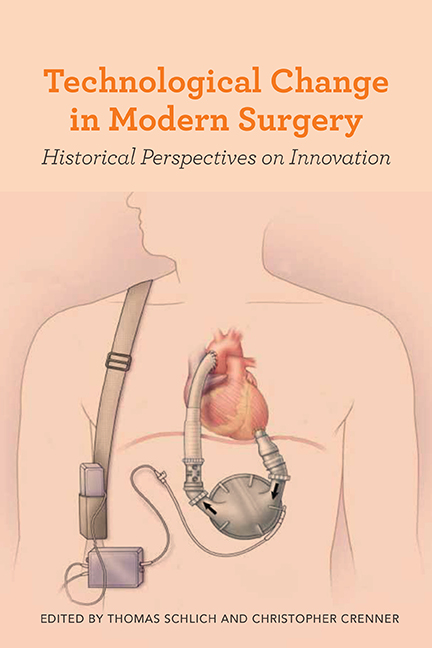Book contents
- Frontmatter
- Dedication
- Contents
- 1 Technological Change in Surgery: An Introductory Essay
- 2 Inimitable Innovation: Johann Friedrich Dieffenbach and the Renewal of Surgery, 1822–1847
- 3 Defining Difference: Competing Forms of Ovarian Surgery in the Nineteenth Century
- 4 “Making Bad Boys Good”: Brain Surgery and the Juvenile Court in Progressive Era America
- 5 Prosthetic Imaginaries: Spinal Surgery and Innovation from the Patient's Perspective
- 6 Disruptive Potential: The “Landmark” REMATCH Trial, Left Ventricular Assist Device (LVAD) Technology, and the Surgical Treatment of Heart Failure in the United States
- 7 Placebos and the Progress of Surgery
- 8 Surgical Practice and the Reconstruction of the Therapeutic Niche: The Case of Myocardial Revascularization
- Bibliography of Secondary Sources
- List of Contributors
- Index
3 - Defining Difference: Competing Forms of Ovarian Surgery in the Nineteenth Century
Published online by Cambridge University Press: 09 June 2021
- Frontmatter
- Dedication
- Contents
- 1 Technological Change in Surgery: An Introductory Essay
- 2 Inimitable Innovation: Johann Friedrich Dieffenbach and the Renewal of Surgery, 1822–1847
- 3 Defining Difference: Competing Forms of Ovarian Surgery in the Nineteenth Century
- 4 “Making Bad Boys Good”: Brain Surgery and the Juvenile Court in Progressive Era America
- 5 Prosthetic Imaginaries: Spinal Surgery and Innovation from the Patient's Perspective
- 6 Disruptive Potential: The “Landmark” REMATCH Trial, Left Ventricular Assist Device (LVAD) Technology, and the Surgical Treatment of Heart Failure in the United States
- 7 Placebos and the Progress of Surgery
- 8 Surgical Practice and the Reconstruction of the Therapeutic Niche: The Case of Myocardial Revascularization
- Bibliography of Secondary Sources
- List of Contributors
- Index
Summary
Introduction
“The perfecting of ovariotomy has resulted in saving and prolonging the lives of multitudes,” the British surgeon John Halliday Croom declared in 1896. Croom was reflecting on an operation that had, over the preceding fifty years, irrevocably altered the landscape of surgery. In the second half of the nineteenth century virtually no other operation garnered as much attention in Britain as that for the removal of diseased ovaries, and during which the operation undulated between controversy and accolade. In the mid-decades those who performed it were frequently lambasted, ridiculed, and even condemned as criminals by opponents who considered its high mortality rate unjustifiable. By the 1890s, with a drastic diminution in the operation's mortality, and a rich archive of printed material now circulating among the medical community that showed hundreds of cases of the operation where the patient had been cured, ovariotomy had ascertained not just respectability but was viewed as emblematic of Victorian progress in medicine. The fruit of ovariotomists’ labor was manifest in the many numbers of patients who had survived the operation and could now return to a life free of ovarian disease. In 1877 Thomas Spencer Wells (1818–97), Britain's most eminent and well-known ovariotomist, gave the address in surgery at the annual meeting of the British Medical Association in Manchester. In his speech Wells proclaimed that his ovariotomy operations alone had added eighteen thousand years to the lives of European women. Such sentiments fitted in with broader understandings Victorian surgeons had of themselves as a civilizing force, both an intellectual and a moral one, their life-saving work a melding of sagacity and selflessness, augmented by the fact that it was women—the wives, mothers, and daughters of Britain—who were being drawn away from the clutches of disease.
Looking back, the history of ovariotomy might initially be viewed as simply one more example of a typically successful medical innovation: the resistance its advocates encountered before improvements in the procedure, and subsequent acceptance among the majority of the profession, marked its introduction into mainstream medicine. Certainty as the first major abdominal procedure to come into practice, ovariotomy raised difficult questions about the propriety and management of innovation as surgeons began to venture into the peritoneal cavity.
- Type
- Chapter
- Information
- Technological Change in Modern SurgeryHistorical Perspectives on Innovation, pp. 51 - 70Publisher: Boydell & BrewerPrint publication year: 2017



